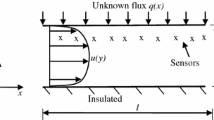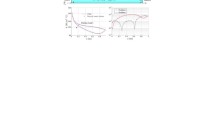Abstract
The heat transfer analysis in a helical coil tube heat exchanger is challenging due to the complex flow field developed by the tube curvature. In this paper, estimation of uneven local heat flux is carried out at the fluid–solid interface in a helical coil tube heat exchanger for laminar and turbulent flow in two different ways. First, the governing continuity, momentum, and energy equations of working fluid for laminar and turbulent flow are solved to determine the heat flux at the fluid–solid interface with commercial CFD software Ansys Fluent. This heat flux is then used as a boundary condition to solve the governing equation of heat conduction in tube thickness by finite volume discretization method to obtain temperature field at the outer tube surface. The heat flux is now considered unknown and estimated with the newly developed enhanced conjugate gradient method (ECGM). ECGM has been designed to enhance the performance of traditional CGM by coupling with the stochastic Jaya algorithm. Ethylene glycol and water has been selected as a working fluid for laminar and turbulent flow, respectively. The average percentage error with ECGM in the estimation of heat flux profile obtained by CFD software in laminar flow and turbulent flow is 0.32 and 0.18 respectively. Even after adding random errors in the simulated temperature field, the ECGM algorithm produces a reasonable and stable solution.














Similar content being viewed by others
Abbreviations
- APE:
-
Average percentage error
- De :
-
Dean number
- dG :
-
Direction of descent
- E:
-
Total specific mechanical energy
- \(\overrightarrow{{\mathrm{f}}_{\mathrm{c}}}\) :
-
Centrifugal force per unit mass (N/kg)
- \(\overrightarrow{\mathrm{g}}\) :
-
Gravitational force per unit mass(N/kg)
- H :
-
Coil pitch (m)
- h :
-
Overall heat transfer coefficient (W/m2K)
- k:
-
Thermal conductivity (W/mK)
- J:
-
Objective function
- M :
-
Number of sensors
- Nu :
-
Nusselt number
- p :
-
Fluid pressure (N/m2)
- Pr:
-
Prandlt number
- q :
-
Heat flux (W/m2)
- R :
-
Coil radius (m)
- \(\overrightarrow{\mathrm{R}}\) :
-
Position vector
- r :
-
Radial coordinate (m)
- Re :
-
Reynolds number
- T :
-
Temperature (K)
- U :
-
Fluid velocity (m/s)
- \(\overrightarrow{V}\) :
-
Velocity vector
- x:
-
Axial coordinate
- a:
-
Actual
- cal:
-
Calculated
- e:
-
Estimated
- eff:
-
Effective
- env:
-
Environment
- ext:
-
External
- int:
-
Internal
- m :
-
Measured
- s :
-
Solid
- t :
-
Tube
- w:
-
Wall
- G:
-
Number of iteration
- ‘:
-
New value
- \({\alpha }\) :
-
Helix angle(rad)
- β:
-
Search step size
- \(\updelta\) :
-
Curvature ratio
- δ(.):
-
Dirac delta function
- \(\Delta\) :
-
Small number
- γ:
-
Conjugation coefficient
- λ:
-
Lagrange multiplier
- \(\upmu\) :
-
Fluid viscosity (Ns/m2)
- \(\nabla\) :
-
Gradient
- ω:
-
Angular velocity (rad/s)
- \(\uprho\) :
-
Fluid density (kg/m3)
- \(\upsigma\) :
-
Standard deviation
- \(\overline{\overline{t} }\) :
-
Stress tensor
- \(\uptheta\) :
-
Angular coordinate (rad
References
Vashisht S, Kumar V, Nigam KDP (2008) A Review on the Potential Applications of Curved Geometries in Process Industry. Ind Eng Chem Res 47:3291–3337
Darvid AN, Smith KA, Merril EW, Brain PLT (1971) Effect of secondary fluid motion on laminar-flow heat-transfer in helically-coiled tubes. AIChE J 17:1142–1222
Dean WR (1927) Note on the motion of fluid in a curved pipe. Philos Mag 4:208
Naphon P, Wongwises S (2016) A review of flow and heat transfer characteristics in curved tubes. Renew Sust Energ Rev 10:463–490
Seban RA, McLaughlin EF (1963) Heat transfer in tube coils with laminar and turbulent flow. Int J Heat Mass Transf 6(5):387–395
Mori Y, Nakayama W (1967) Study of forced convective heat transfer in curved pipes. Int J Heat Mass Transf 10:37–59
Ko TH (2006) Thermodynamic analysis of optimal curvature ratio for fully developed laminar forced convection in a helical coiled tube with uniform heat flux. Int J Thermal Science 45:729–737
Xin RC, Ebadian MA (1997) The effects of Prandtl numbers on local and average convective heat transfer characteristics in helical pipes. J Heat Transf 467–473
Bai B, Guo L, Feng Z, Chen X (1999) Turbulent heat transfer in a horizontal helically coiled tube. Heat Transfer Asian Res 28:395–403
Bozzoli F, Cattani L, Rainieri S, Bazan FSV, Borges LS (2014) Estimation of the local heat-transfer coefficient in the laminar flow regime in coiled tubes by the Tikhonov regularisation method. Int J Heat Mass Transf 72:352–361
Bozzoli F, Cattani L, Mocerino A, Rainieri S (2018) Turbulent flow regime in coiled tubes: local heat-transfer coefficient. Heat Mass Transfer 54:2371–2381
Di Piazza I, Ciofalo M (2010) Numerical prediction of turbulent flow and heat transfer in helically coiled pipes. Int J Therm Sci 49(4):653–663
Jayakumar JS, Mahajani SM, Mandal JS, Iyer KN, Vijayan PK (2010) CFD analysis of single-phase flows inside helically coiled tubes. Comput Chem Eng 34(4):430–446
Di Liberto M, Ciofalo M (2013) A study of turbulent heat transfer in curved pipes by numerical simulation. Int J Heat Mass Transf 59:112–125
Ferng YM, Lin WC, Chieng CC (2012) Numerically investigated effects of different dean number and pitch size on flow and heat transfer characteristics in a helically coil-tube heat exchanger. Appl Therm Eng 36:378–385
Ozisik MN, Orlande HRB (2000) Inverse Heat Transfer: Fundamentals and Applications. Taylor and Francis, New York
Huang CH, Ozisik MN (1992) Inverse Problem of Determining Unknown Wall Heat Flux in Laminar Flow through Parallel Plate Duct. Numer Heat Transfer A 21:55–70
Bokar JC, Ozisik MN (1995) An inverse analysis for estimating the time-varying inlet temperature in laminar flow inside a parallel plate duct. Int J Heat Mass Transfer 38:39–45
Machado HA, Orlande HRB (1997) Inverse analysis for estimating the timewise and spacewise variation of the heat flux in a parallel plate channel. Int J Numer Methods Heat Fluid Flow 7:696–710
Mohebbi F, Sellier M (2016) Estimation of thermal conductivity, heat transfer coefficient, and heat flux using a three dimensional inverse analysis. Int J Thermal Science 99:258–270
Benmachiche AH, Bougriou C, Abboudi C (2010) Inverse determination of the heat transfer characteristics on a circular plane fin in a finned-tube bundle. Heat Mass Transfer 46:1367–1377
Li HY, Yang CY (1997) A Genetic Algorithm for Inverse Radiation Problems. Int J Heat Mass Transfer 40:1545–1549
Liu FB (2008) A modified genetic algorithm for solving the inverse heattransfer problem of estimating plan heat source. Int J Heat Mass Transfer 51:3745–3752
Shafipour M, Safavinejad A, Zadeh MA (2019) Inverse estimation of boundary conditions with forced convection heat transfer in two dimensional channels. Heat Mass Transfer 55:1927–1935
Wang X, Li H, Li Z (2018) Estimation of interfacial heat transfer coefficient in inverse heat conduction problems based on artificial fish swarm algorithm. Heat Mass Transfer 54:3151–3162
Ding P, Xu M, Sun D (2012) Estimation of unknown inlet temperature profile using an improved Gbest-PSO. J Information Science Eng 28:67–82
Parwani AK, Talukdar K, Subbarao PMV (2013) Simultaneous estimation of strength and position of heat source in participating medium using DE algorithm. J Quantitative Spectroscopy Radiative Heat Transfer 127:130–139
Vaka AS, Ganguly S, Talukdar P (2021) Novel inverse heat transfer methodology for estimation of unknown interfacial heat flux of a continuous casting mould: A complete three-dimensional thermal analysis of an industrial slab mould. Int J Thermal Science 160(106648):1–13
Lv C, Wang G, Chen H, Wan S (2019) Estimation of the moving heat source intensity using the multiple model adaptive inverse method. Int J Thermal Science 138:576–585
Neto AJS, Soeiro FJCP (2003) Solution of implicitly formulate inverse heat transfer problems with hybrid methods. Second MIT Conference on Computational Fluid and Solid Mechanics 2369–2372
Kim KW, Baek SW, Kim MY, Ryou HS (2004) Estimation of emissivities in a two-dimensional irregular geometry by inverse radiation analysis using hybrid genetic algorithm. J Quantitative Spectroscopy Radiative Heat Transfer 87:1–14
Chen HT, Wu XY (2008) Investigation of heat transfer coefficient in two-dimensional transient inverse heat conduction problems using the hybrid inverse scheme. Int J Numer Methods Eng 73:107–122
Parwani AK, Talukdar P, Subbarao PMV (2013) Performance evolution of hybrid differential evolution approach for estimation of the strength of heat source in a radiatively participating medium. Int J Heat Mass Transfer 56:552–560
Parwani AK, Talukdar P, Subbarao PMV (2014) A hybrid approach using CGM and DE algorithm for estimation of boundary heat flux in parallel plate channel. Numer Heat Trans A(65):461–481
Liu FB (2011) A hybrid method for the inverse heat transfer of estimating fluid thermal conductivity and heat capacity. Int J Thermal Science 50:718–724
Rao RV (2016) Jaya: A simple and new optimization algorithm for solving constrained and unconstrained optimization problems. Int J Industrial Engineering Computations 7:19–34
Rao RV, Rai DP, Ramkumar J, Balic J (2016) A new multi objective Jaya algorithm for optimization ofmodern machining processes. Advances in Production Engineering & Management 11:271–286
Rao RV, Saroj A (2017) Constrained economic optimization of shell-and-tube heat exchangers using elitist-Jaya algorithm. Energy 128:785–800
Valdes M, Ardila JG, Colorado D, Escobedo-Trujillo BA (2019) Computational Model to Evaluate the Effect of Passive Techniques in Tube-In-Tube Helical Heat Exchanger. Energies 12:1–12
White FM (2006) Viscous fluid flow, 3rd edn. Tata McGrow Hill Publications, New York
Menter FR (1994) Two-equation eddy-viscosity turbulence models for engineering applications. AIAA J 32:269–289
Patankar SV, Pratap VS, Spalding DB (1974) Prediction of laminar flow and heat transfer in helically coiled pipes. J Fluid Mech 2:539–551
Yang G, Ebadian MA (1996) Turbulent forced convection in a helicoidal pipe with substantial pitch. Int J Heat Mass Transf 39:2015–2022
Patankar SV (2018) Numerical Heat transfer and Fluid Flow, Hemisphere Publishing Corporation, New York
Engl HW (1987) Discrepancy principle for tikhonov regularization of ill-posed problems leading to optimal convergence rates. J Optimizar Theory Applications 52:209–215
Acknowledgements
The author acknowledges the grant (EMR/2016/007821/CME) of Science and Engineering Research Board, Department of Science and Technology, Government of India and greatly appreciate the financial contribution towards this research.
Author information
Authors and Affiliations
Corresponding author
Ethics declarations
Conflicts of Interest
On behalf of all authors, the corresponding author states that there is no conflict of interest.
Additional information
Publisher's Note
Springer Nature remains neutral with regard to jurisdictional claims in published maps and institutional affiliations.
Rights and permissions
About this article
Cite this article
Shah, S., Parwani, A.K. Estimation of local heat flux with CFD and enhanced conjugate gradient method for laminar and turbulent flow in a helical coil tube heat exchanger. Heat Mass Transfer 58, 917–931 (2022). https://doi.org/10.1007/s00231-021-03138-2
Received:
Accepted:
Published:
Issue Date:
DOI: https://doi.org/10.1007/s00231-021-03138-2




